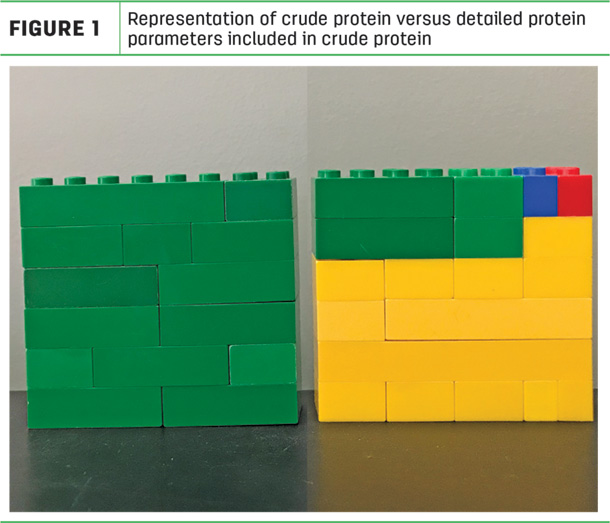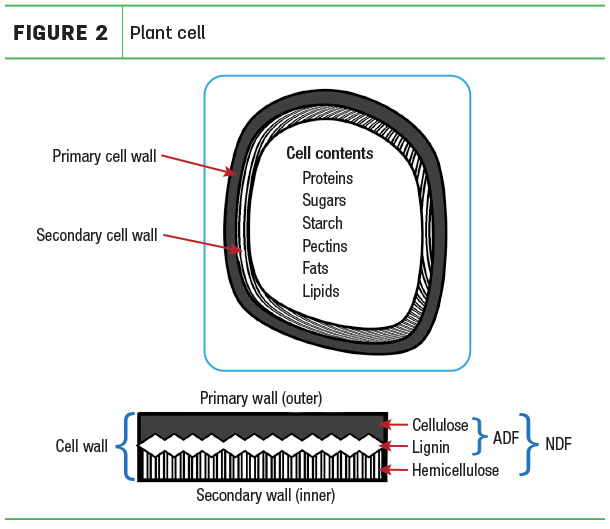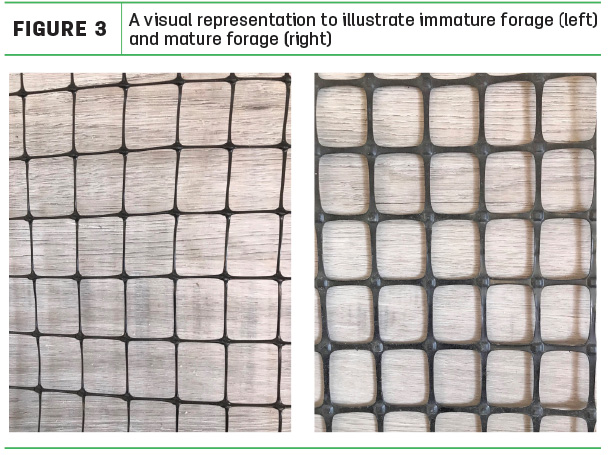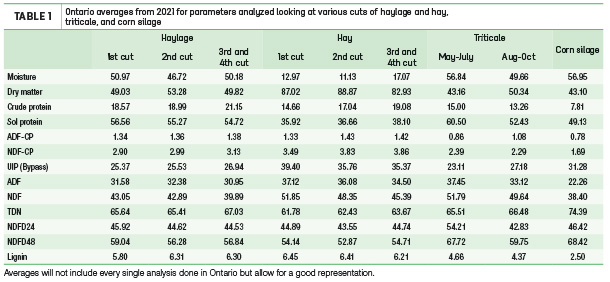Over the last 25 years, animal production has improved significantly to have more milk and meat production per animal. To support our ability to feed and manage modern animals, technology to better analyze feed ingredients has also changed to keep up with production.
Feeds are more thoroughly analyzed today than ever before. Laboratory analyses provides the best indication of nutrient availability, allowing feeds to be utilized to their full potential. Although the layout of reports may vary between laboratories, the parameters indicated to provide a balanced diet are included in most feed analysis reports.
All reports will include the dry matter of a feedstuff because moisture dilutes the concentrations of the nutrients present, and it is standard practice to evaluate the feed and balance rations using a dry matter basis.
Crude protein (CP) is a term calculated based on the nitrogen content of the feedstuff. Without looking at the type of protein it is made up of, CP only tells us that it contains nitrogen. The report generally splits the CP parameter down further into soluble protein, acid detergent fibre-CP (ADF-CP), neutral detergent fibre-CP (NDF-CP) and undegradable intake protein (UIP), also known as bypass protein. To appreciate the values of each on the analysis report, a basic understanding of these terms is needed.
Looking at Figure 1, the green wall on the left represents the total CP of a forage analysis.

By looking at the green wall, it appears to contain all the same proteins. However, when we look at the wall on the right, we can see the same amount of CP can be broken up into more parameters. Thanks to laboratory analysis, we know how much each parameter represents of the total CP. The yellow bricks show the portion of soluble protein, the green bricks represent the UIP (bypass protein), and the blue and red bricks show the NDF-CP and ADF-CP, respectively.
Soluble protein, the largest portion of CP, is also the most readily available. This consists of small amino acid chains, or non-protein nitrogen that will solubilize in rumen fluid and be absorbed across the rumen wall. Soluble protein is the same whether you look at the “as fed” or “dry matter” columns on the analysis results because it is a percentage of the total CP. Bypass protein is the fraction of protein resistant to degradation by rumen microbes. This fraction goes by a few other names, like UIP and rumen-undegradable protein (RUP). It is valued because it can be absorbed in the small intestine.
Figure 2 illustrates the portions of a cell wall.

Acid detergent fibre (ADF) refers to the cell wall portion of the forage and is made up of lignin and cellulose (the outer layer of the cell wall). The value is important, as it relates to the animal’s ability to digest the forage; a higher ADF suggests a decrease in digestibility. Neutral detergent fibre (NDF) refers to the cell wall fraction that includes both ADF (outer cell wall and lignin) and hemicellulose (inner cell wall). The NDF value is related to the amount of forage the animal can consume and, as NDF increases, dry matter intake (DMI) generally decreases. Lignin, located between the outer and inner cell wall, is the indigestible portion of the plant cell. Think of it as a glue stick sitting as a pillar between the inner and outer wall, holding both together. This number will increase with forage maturity and therefore negatively impacts the digestion of the cell wall, acting as a physical barrier to microbial enzymes.
The ADF-CP is associated with the portion of the CP unavailable to the animal as a result of heat damage. In forages, this can be natural heating of fermentation, although for some feed ingredients, it is the actual heating process. Elevated values of ADF-CP indicate overheating has occurred and could mean a potential reduction in feed quality, making less feedstuff usable to the microbes and thus to the animal.
NDF-CP is like ADF-CP, wherein it has some digestibility associated with it. Usually, the NDF-CP is linked to bypass protein, meaning as NDF-CP increases, bypass protein will also increase.
In addition, NDF will at times be specified as aNDF, where the “a” indicates amylase – an enzyme – has been used during the NDF procedure to remove any starches. The next extension is aNDFom, where the NDF is ash-corrected. It differs from NDF and aNDF in that it is free of ash. The sample is heated, leaving ash residue. The ash is then weighed and subtracted from the NDF portion, giving ash-free NDF, or aNDFom. The ash content on a laboratory analysis is often due to the soil content of the analyzed sample. The ash content can be affected by flooded areas, heavy rains or equipment picking up the soil during harvest, to name a few.
Neutral detergent fibre digestibility (NDFD), as the term indicates, allows us to know how digestible the forage is for the rumen bugs. An NDFD24 and NDFD48 indicate the number of hours the in vitro digestibility test lasted to determine the digestibility of the feed source. In other words, how much NDF was digested in 24 and 48 hours, respectively, by rumen bugs in the rumen fluid. It gives an indication whether the feed is being used efficiently by the rumen microbes. This digestibility is affected by the lignin content of the feedstuff.
To illustrate this point, see Figure 3 for a visual representation of how forage cell walls differ with maturity.

Imagine both sides of the figure represent the cell walls holding a forage together. As the forage matures, the cell wall thickens, as seen in the two cell walls illustrated by Figure 3, comparing the immature plant to the mature plant. When the cell wall thickens, the lignin, ADF and NDF have increased, therefore, making the stem of the plant harder to digest by the rumen bugs.
The relative feed value (RFV) is not used much anymore to evaluate forages, but at times it is still recorded on the certificate of analysis, using ADF and NDF in its calculation. Although protein is not considered in the calculation, generally a higher RFV indicates a higher protein. An RFV of 100 indicates it is decent-quality hay, whereas an RFV of 150 is exceptionally good hay. However, when comparing an alfalfa to a grass, the NDF has a much higher impact in the RFV equation.
With fresh clippings of spring alfalfa, the NDF will be in the low to mid 20% range, whereas at the same point in time, grass would be in the 40% range. This seems high, but the NDF of a grass doesn’t change nearly as much during maturation as that of alfalfa. At harvest, a grass may have an NDF in the low 50% range, similar to where an alfalfa will be at harvest. The value of NDF contributes three times as much as ADF in the RFV equation. Therefore, there is a shift towards using relative feed quality (RFQ), which considers the digestibility of forages.
Ontario averages for feed analyzed in 2021 are shown in Table 1.

Homegrown feed nutrient composition can be affected by geographical locations in addition to variations due to timing of manure or fertilizer application, harvesting methods, timing and harvesting techniques.
The figures shown in Table 1 are averages, and no analysis of feedstuff will consistently fall in the ideal range of each parameter. What is important to remember is: None of these ingredients are used on their own. A nutritionist has capabilities to provide animals with the optimal ration using various ingredients. Looking at Table 1, the haylage samples follow a typical pattern where the CP increases with each cut. This past year, the digestibility of the haylage samples – on average – were slightly lower than other years, though still very suitable for use in a ration. Triticale, which is often planted due to a shortage in feed or intended as good youngstock or dry cow feed, has respectable numbers that can make it valuable in a lactating ration as well.
Corn silage is known for its volume of feed, starch and energy – in other words, its total digestible nutrient (TDN) content. Soluble protein becomes more available as corn ferments, so testing regularly is advised.
Laboratories update technology and continue to do their best to calibrate equipment; however, small variations may occur. Nevertheless, plenty of reliable information is available for a given sample to aid in precise feeding, allowing producers to meet the nutritional demands of their animals.
The author would like to acknowledge A & L Laboratories for contributing Ontario averages for the purpose of this article. The author acknowledges that not all readers reside in Ontario.
-
Anita Heeg
- Feed Ingredients and Byproducts Specialist
- Ontario Ministry of Agriculture, Food and Rural Affairs









